Kidde AC Hardwired Smoke Alarm i12060A Guide
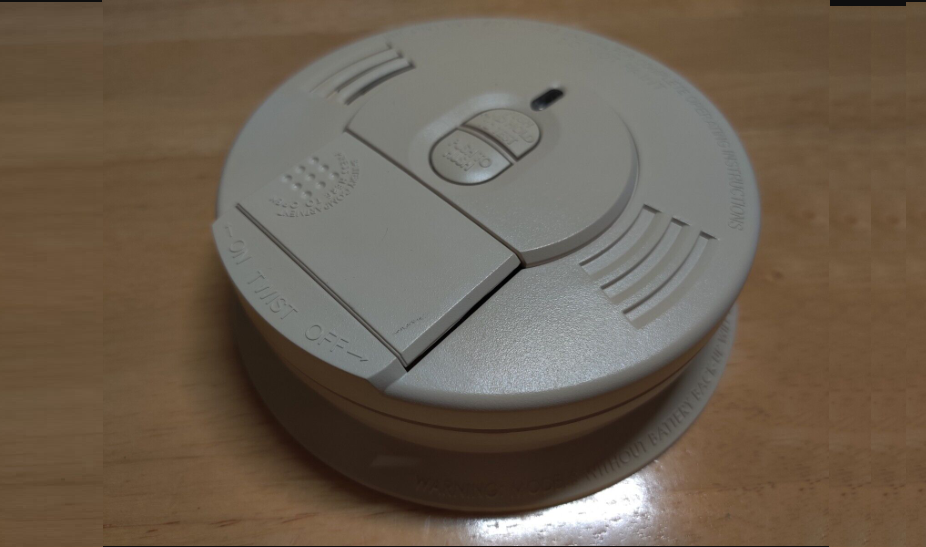
Content

Introduction of Kidde AC Hardwired Smoke Alarm i12060A
The Kidde AC Hardwired Smoke Alarm i12060A is a top-of-the-line smoke detector designed to provide reliable protection for your home or business. This smoke alarm is hardwired into your electrical system, ensuring constant power and eliminating the need for frequent battery changes. The estimated price for the i12060A is around $25-$30, making it an affordable option for anyone looking for high-quality smoke detection. The product was launched in 2018 and has been a popular choice for homeowners and businesses ever since.
Detailed Specifications
The Kidde AC Hardwired Smoke Alarm i12060A features the following specifications:
- Hardwired electrical connection with battery backup
- Ionization sensing technology
- Single button test and silence feature
- LED indicator for alarm and power status
- Interconnectability with up to 24 devices
- 10-year limited warranty
RECOMMENDED LOCATIONS FOR ALARMS
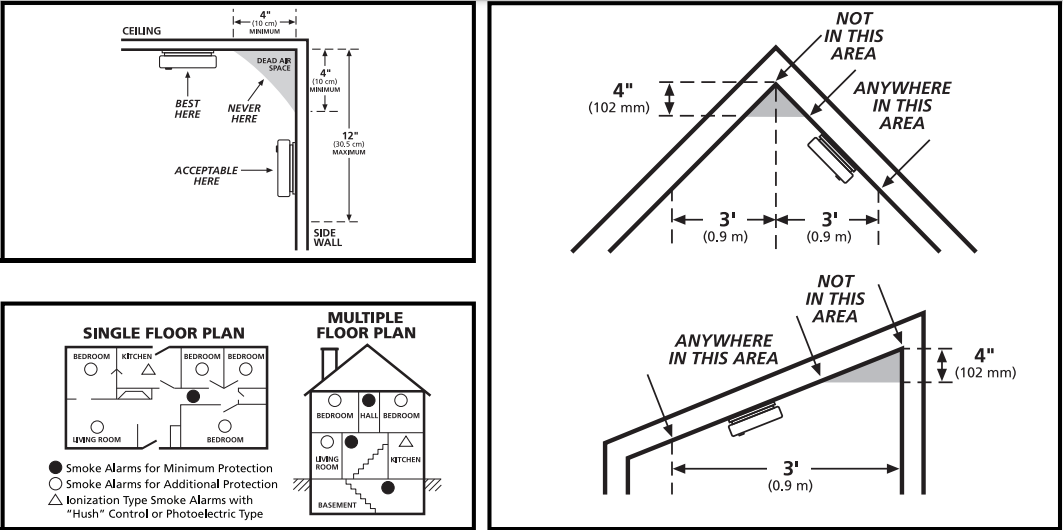
- Locate the first alarm in the immediate area of the bedrooms. Try to monitor the exit path as the bedrooms are usually farthest from the exit. If more than one sleeping area exists, locate additional alarms in each sleeping area.
- Locate additional alarms to monitor any stairway as stairways act like chim-neys for smoke and heat.
- Locate at least one alarm on every floor level.
- Locate an alarm in every sleeping room.
- Locate an alarm in every room where electrical appliances are operated (i.e. portable heaters or humidifiers).
- Locate an alarm in every room where someone sleeps with the door closed. The closed door may prevent an alarm not located in that room from waking the sleeper.
- Smoke, heat, and combustion products rise to the ceiling and spread horizon-tally. Mounting the smoke alarm on the ceiling in the center of the room places it closest to all points in the room. Ceiling mounting is preferred in ordinary residential construction.
- For mobile home installation, select locations carefully to avoid thermal barriers that may form at the ceiling. For more details, see MOBILE HOME INSTALLATION.
- When mounting an alarm on the ceiling, locate it at a minimum of 4” (10 cm) from the side wall (see FIGURE 1).
- When mounting the alarm on the wall, use an inside wall with the top edge of the alarm at a minimum of 4” (10 cm) and a maximum of 12” (30.5 cm) below the ceiling (see FIGURE 1).
- Put smoke alarms at both ends of a bedroom hallway or large room if the hallway or room is more than 30 feet (9.1 m) long.
- Install Smoke Alarms on sloped, peaked or cathedral ceilings at or within 3ft (0.9m) of the highest point (measured horizontally). NFPA 72 states: “Smoke alarms in rooms with ceiling slopes greater than 1 foot in 8 feet (.3m in 2.4 m) horizontally shall be located on the high side of the room.” NFPA 72 states: “A row of detectors shall be spaced and located within 3 ft (0.9m) of the peak of the ceiling measured horizontally” (see FIGURE 3).
MOBILE HOME INSTALLATION
- Modern mobile homes have been designed and built to be energy efficient. Install smoke alarms as recommended above (refer to RECOMMENDED LOCA-TIONS and FIGURES 1 and 2).
- In older mobile homes that are not well insulated compared to present stan-dards, extreme heat or cold can be transferred from the outside to the inside through poorly insulated walls and roof. This may create a thermal barrier which can prevent the smoke from reaching an alarm mounted on the ceiling. In such units, install the smoke alarm on an inside wall with the top edge of the alarm at a minimum of 4” (10 cm) and a maximum of 12” (30.5 cm) below the ceiling (see FIGURE 1).
- If you are not sure about the insulation in your mobile home, or if you notice that the outer walls and ceiling are either hot or cold, install the alarm on an inside wall. For minimum protection, install at least one alarm close to the bed-rooms. For additional protection, see SINGLE FLOOR PLAN in FIGURE 2.
WARNING: TEST YOUR SMOKE ALARM OPERATION AFTER MOBILE HOME VEHICLE HAS BEEN IN STORAGE, BEFORE EACH TRIP AND AT LEAST ONCE A WEEK DURING USE.
LOCATIONS TO AVOID
- In the garage. Products of combustion are present when you start your auto-mobile.
- Less than 4” (10cm) from the peak of an “A” frame type ceiling.
- In an area where the temperature may fall below 40ºF (4.4˚C) or rise above 100ºF (37.8˚C), such as garages and unfinished attics.
- In dusty areas. Dust particles may cause nuisance alarm or failure to alarm.
- In very humid areas (greater than 95% R.H.), non-condensing. Moisture or steam can cause nuisance alarms.
- In insect-infested areas.
- Smoke alarms should not be installed within 3 ft (.9m) of the following: the door to a kitchen, the door to a bathroom containing a tub or shower, forced air supply ducts used for heating or cooling, ceiling or whole house ventilating fans, or other high air flow areas.
- Kitchens. Normal cooking may cause nuisance alarms. If a kitchen alarm is desired, it should have an alarm silence feature or be a photoelectric type.
- Near fluorescent lights. Electronic “noise” may cause nuisance alarms.
- Smoke alarms are not to be used with detector guards unless the combination (alarm and guard) has been evaluated and found suitable for that purpose.
INSTALLATION INSTRUCTIONS
WIRING REQUIREMENTS
- This smoke alarm should be installed on a U.L. listed or recognized junction box. All connections should be made by a qualified electrician and all wiring used shall be in accordance with articles 210 and 300.3(B) of the U.S. National Electrical Code ANSI/NFPA 70, NFPA 72 and/or any other codes having jurisdiction in your area. The multiple station interconnect wiring to the alarms must be run in the same raceway or cable as the AC power wiring. In addition, the resistance of the interconnect wiring shall be a maximum of 10 ohms.
- The appropriate power source is 120 Volt A.C. Single Phase supplied from a non-switchable circuit which is not protected by a ground fault interrupter.
WARNING: This alarm cannot be operated from power derived from a square wave, modified square wave or modified sine wave inverters. These types of inverters are sometimes used to supply power to the structure in off grid installations, such as solar or wind derived power sources. These power sources produce high peak voltages that will damage the alarm.
WIRING INSTRUCTIONS FOR A.C. QUICK CONNECT HARNESS
CAUTION! TURN OFF THE MAIN POWER TO THE CIRCUIT BEFORE WIRING THE ALARM.
- For alarms that are used as single station, DO NOT CONNECT THE RED WIRE TO ANYTHING. Leave the red wire insulating cap in place to make certain that the red wire cannot contact any metal parts or the electrical box.
- When alarms are interconnected, all interconnected units must be powered from a single circuit.
- A maximum of 24 Kidde devices may be interconnected in a multiple station arrangement. The interconnect system should not exceed the NFPA interconnect limit of 12 smoke alarms and/or 18 alarms total (smoke, heat, carbon monoxide, etc.). With 18 alarms interconnected, it is still possible to interconnect up to a total of 6 remote signaling devices and/or relay modules.
- When mixing models which have battery backup (1275, 1276, 1285, 1296, i12040, i12040A, i12060, i12060A, i12080, i12080A, i4618, i4618A, PE120, P12040, PI2000, PI2010, KN-
- COPE-i, KN-SM-FM-i, KN-COSM-IB,
- KN-COSM-IBA, HD135F, KN-COB-IC, KN-COP-IC, i12010S, i12010SCO,
- RF-SM-ACDC) with models without battery backup, (1235, i12020, i12020A, KN-COSM-I,120X, SM120X, CO120X, SL177i, SLED177i) be advised that the models without battery backup will not respond during an AC power failure.
- For more information about compatible interconnect units and their functionality in an interconnect system, visit our web site at: www.Kidde.com
- The maximum wire run distance between the first and last unit in an interconnected system is 1000 feet.
- Figure 4 illustrates interconnection wiring. Improper connection will result in damage to the alarm, failure to operate, or a shock hazard.
Make certain alarms are wired to a continuous (non-switched) power line.
NOTE: Use standard UL listed household wire (as required by local codes) avail-able at all electrical supply stores and most hardware stores.

INTERCONNECT WIRING DIAGRAM
| Wire Color | Connection To |
|---|---|
| Black | Hot Side of A.C. Line |
| White | Neutral Side of A.C. Line |
| Red | Interconnect Lines of Other Units in the Multiple Station Setup |
BATTERY INSTALLATION
CAUTION! THIS UNIT WILL NOT FUNCTION WITH-OUT A PROPERLY INSTALLED BATTERY, AND IS EQUIPPED WITH A BATTERY LOCKOUT FEATURE WHICH PREVENTS THE BATTERY CARRIER FROM CLOSING IF A BATTERY IS NOT INSTALLED CORRECTLY.
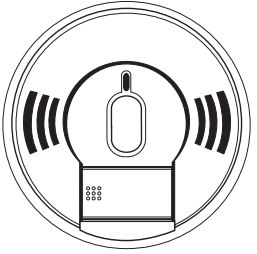
MOUNTING INSTRUCTIONS
CAUTION: WHEN WALL MOUNTING: UNIT MUST BE MOUNTED SO THAT THE BATTERY BOX FACES DOWN! (SEE FIGURE 5). INCORRECT ORIENTATION OF WALL MOUNTED SMOKE ALARMS WILL DECREASE OPERATIONAL EFFEC-TIVENESS.
- Remove the trim ring from the back of the alarm by holding the trim ring and twisting the alarm counter-clockwise.
After selecting the proper smoke alarm location as described in Section 1 and wiring the AC Quick Connector as described in the WIRING INSTRUCTIONS, attach the trim ring to the electrical box. To ensure aesthetic align-ment of the alarm with the hallway or wall, the “A” line on the mounting bracket must be parallel with the hallway when ceiling mounted, or horizontal when wall mounted.

- Pull the AC QUICK CONNECTOR through the center hole in the mounting bracket and secure the bracket, making sure that the mounting screws are posi-tioned in the small ends of the keyholes before tightening the screws.
- Plug the AC QUICK CONNECTOR into the back of the alarm (see Figure 7), making sure that the locks on the connector snap into place. Then push the excess wire back into the electrical box through the hole in the center of the mounting bracket.
Install the alarm on the mounting bracket and rotate the alarm clockwise until the alarm ratchets into place (this ratcheting function allows for aesthetic alignment).
NOTE: The alarm will mount to the bracket in 4 positions (every 90 degrees). When wall mounting, make sure the battery box is at the bottom of the unit.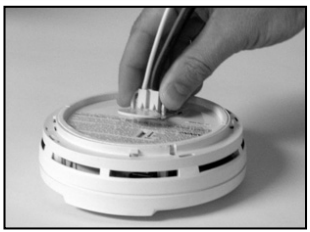
- Pull the Battery Pull Tab (yellow tab protruding from the unit) completely out of the unit. This will automatically connect the battery.
- Test the unit to ensure proper operation by pressing the Test/Hush Button for a minimum of 5 seconds. (All interconnected, battery backed up, alarms should respond).
CAUTION: Due to the loudness (85 decibels) of the alarm, always stand an arms length away from the unit when testing. - Turn on the AC power. The green Power On Indicator should be lit when the alarm is operating from AC power. Confirm unit operation by pressing the
Test/Hush button.
TAMPER RESIST FEATURES
Smoke Alarm Tamper Resist Feature
This alarm has a tamper resist feature, which helps prevent someone from removing the unit from the mounting bracket. When used in conjunction with the Battery Carrier Tamper Resist Feature, it can be very effective in preventing smoke alarm tampering and battery removal.
Activate the smoke alarm tamper resist feature by breaking off the four posts in the square holes in the mounting bracket (see Figure 8A). When the posts are broken off, the tamper resist tab on the base is allowed to engage the mounting bracket. Rotate the alarm onto the mounting bracket until you hear the tamper resist tab snap into place, locking the alarm on the mounting bracket. Using the tamper resist feature will help deter children and others from removing the alarm from the bracket.
NOTE: To remove the alarm when the tamper resist tab is engaged, press down on the tamper resist tab, and rotate the alarm off the bracket.

Battery Carrier Tamper Resist Feature
This alarm has a battery carrier tamper resist feature, which helps prevent the battery carrier from being opened. This feature is effective in preventing the removal of the battery from this device (which will render the unit inoperable during the loss of AC power).
To activate the battery carrier tamper resist feature, remove the unit from the trim plate, disconnect the AC quick connector and locate the small cut-out in the middle of the product label on the back of the unit. With a small screwdriver, or similar tool, move the slider towards the lock position as indicated by the arrow. The tamper resist feature is now active and the battery carrier can not be opened until the tamper resist feature is deactivated.
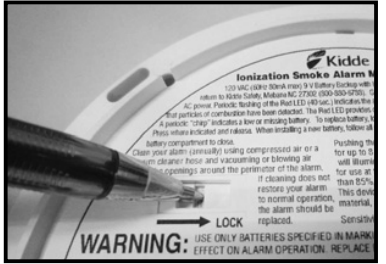
NOTE: Before activating the battery carrier tamper resist feature, make sure a fresh battery is installed in the unit and that the battery carrier is properly closed. If the FIGURE 9 battery carrier tamper resist feature is activated while the battery carrier is open, the battery carrier will not close and the unit will be inoperable during the loss of AC power.
To deactivate the battery carrier tamper resist, in order to change the smoke alarm battery, remove the unit from the trim plate (see Smoke Alarm Tamper Resist Feature if activated), disconnect the AC quick connector and locate the small cut-out in the middle of the product label. Using a screwdriver, or similar tool, move the slider away from the lock position (opposite the direction indicated by the arrow). The battery carrier can now be opened and the battery changed.
Description of Kidde AC Hardwired Smoke Alarm i12060A
The Kidde AC Hardwired Smoke Alarm i12060A is designed to provide reliable smoke detection for your home or business. This smoke alarm is hardwired into your electrical system, ensuring constant power and eliminating the need for frequent battery changes. The ionization sensing technology detects both smoldering and flaming fires, providing early warning and allowing for safe evacuation. The single button test and silence feature makes it easy to test and maintain the smoke alarm, while the LED indicator provides visible verification of alarm and power status. The i12060A is also interconnectable with up to 24 devices, allowing for synchronized alarms throughout your home or business.
OPERATION AND TESTING
OPERATION: The smoke alarm is operating once A.C. power is applied, fresh batteries are installed and testing is complete. When the smoke alarm ionization chamber senses products of combustion, the horn will sound a loud (85db) temporal alarm until the sensing chamber is cleared of smoke particles.
HUSHTM CONTROL: The “HUSH” feature has the capability of temporarily desensitizing the alarm circuit for up to 8 minutes. This feature is to be used only when a known alarm condition, such as smoke from cooking, activates the alarm.The smoke alarm is desensitized by pushing the “TEST/HUSH” button on the smoke alarm cover. If the smoke is not too dense, the alarm will silence immediately. The red LED will illuminate for 1.5 seconds every 8-10 seconds while in hush. This indicates that the alarm is in a temporarily desensitized condi-tion. The smoke alarm will automatically reset after approximately 8 minutes and sound the alarm if particles of combustion are still present. The “HUSH” feature can be used repeatedly until the air has been cleared of the condition causing the alarm. Pushing the Test/Hush button on the alarm will end the hush period.
This alarm has a low battery HUSH feature. If the alarm is sounding a low battery warning chirp, you can silence this chirp for approximately 13 hours by pressing the Test/Hush button.
NOTE: DENSE SMOKE WILL OVERRIDE THE HUSH CONTROL FEATURE AND SOUND A CONTINUOUS ALARM.
CAUTION: BEFORE USING THE ALARM HUSH FEATURE, IDENTIFY THE SOURCE OF THE SMOKE AND BE CERTAIN A SAFE CONDITION EXISTS.
LED INDICATORS: This smoke alarm is equipped with red and green LED indicators. The green LED (when illuminated) indicates the presence of AC power.
The red LED has four modes of operation:
- Standby Condition
The red LED will flash approximately every 40 seconds to indicate that the smoke alarm is operating properly. - Alarm Condition
When the alarm senses products of combustion and goes into alarm, the red LED will flash one flash per second. The flashing LED and pulsating alarm will continue until the air is cleared. WHEN UNITS ARE INTERCONNECTED, only the red LED of the alarm which senses the smoke or is being tested (the originating unit) will flash. All other units in the interconnect system will sound an alarm but their red LED’s will NOT be flashing. - Alarm Memory
This smoke alarm is equipped with an alarm memory, which provides a visual indication when an alarm has been activated. The red LED will illuminate for about 1.5 seconds every 20 seconds to indicate the memory condition. The memory will remain activated until pushing the Test/Hush Button resets it or will time-out between 11 to 13 hours. In an interconnected installation only the memory of the originating alarm will be activated. - Hush mode
The red LED will illuminate for 1.5 seconds every 10 seconds, indicating the smoke alarm is in the Hush® mode.
TESTING: Test by pushing the Test/Hush button on the cover and hold it down for a minimum of 5 seconds. This will sound the alarm if all the electronic circuitry, horn and battery are working. In an interconnected installation all inter-connected alarms should sound when the test feature on any one of the inter-connected alarms is activated. If no alarm sounds, check the fuse or circuit breaker supplying power to the alarm circuit. If the alarm still does not sound, the unit has defective batteries or other failure. DO NOT use an open flame to test your alarm, you could damage the alarm or ignite combustible materials and start a structure fire.
TEST THE ALARM WEEKLY TO ENSURE PROPER OPERATION. Erratic or low sound coming from your alarm may indicate a defective alarm, and it should be returned for service (see Section 12).
NUISANCE ALARMS
Smoke alarms are designed to minimize nuisance alarms. Cigarette smoke will not normally set off the alarm, unless the smoke is blown directly into the alarm. Combustion particles from cooking may set off the alarm if the alarm is located close to the cooking area. Large quantities of combustible particles are generated from spills or when broiling. Using the fan on a range hood which vents to the outside (non-recirculating type) will also help remove these combustible products from the kitchen. Model i12060A has a “HUSH” feature that is extremely useful in a kitchen area or other areas prone to nuisance alarms.check to see if one of the reasons listed in Section 2 may have caused the alarm.
MAINTENANCE
ALARM REMOVAL
IF SMOKE ALARM TAMPER RESIST FEATURE HAS BEEN ACTIVATED, REFER TO SMOKE ALARM TAMPER RESIST FEATURE IN SECTION 3 FOR REMOVAL INSTRUCTIONS.
To remove the alarm from the trim ring, rotate the alarm counter clockwise in the direction of the "OFF" arrow on the cover. To disconnect the A.C. power harness, squeeze the locking arms on the sides of the Quick Connector while pulling the connector away from the bottom of the alarm (see Section 3, Figure 7).
BATTERY INSTALLATION AND REMOVAL
Note: If battery carrier tamper resist feature has been activated it will need to be deactivated in order to change the battery.
- To replace or install the batteries press down on the battery carrier and then release to allow the carrier to pop open. The battery can then be pulled out of the carrier. When installing a new battery into the carrier, make sure the battery terminals are exposed and that the polarity matches the markings printed on the battery carrier. Completely press the battery carrier down into the alarm and release, the battery carrier will lock into the closed position.
- A missing or improperly installed battery will prevent the battery carrier from closing and result in improper alarm operation.
This smoke alarm uses a 9V carbon zinc battery (alkaline batteries may also be used). A fresh battery should last for one year under normal operating conditions.

This alarm has a low/missing battery monitor circuit which will cause the alarm to “chirp” approximately every 30-40 seconds for a minimum of seven (7) days when the battery gets low. Replace the battery when this condition occurs.
NOTE: Low/missing battery monitor circuit WILL cause the unit to chirp while replacing the battery. This function will cease once the new battery has been installed. To avoid this “chirp” the unit can be removed from the base and dis-connected from the AC power when replacing the battery, but it is not necessary.
USE ONLY THE FOLLOWING 9 VOLT BATTERIES FOR SMOKE ALARM BATTERY REPLACEMENT.
| Battery Type | Models |
|---|---|
| Carbon-Zinc | EVEREADY 1222, GOLD PEAK 1604P, 1604S, GOLDEN POWER G6F22M |
| Alkaline | ENERGIZER 522, DURACELL MN1604, MX1604, GOLD PEAK 1604A, PANASONIC 6AM6, 6AM-6, 6AM-6PI, 6AM6X, 6LR61 (GA) |
NOTE: Do not use lithium batteries in this unit. These batteries can be purchased at your local retailer.
NOTE: WEEKLY TESTING IS REQUIRED!
WARNING! BE SURE TO FOLLOW BATTERY INSTALLATION INSTRUCTIONS PRINTED ON THE BACK OF THE ALARM AND USE ONLY THE BATTERIES SPECI-FIED. USE OF DIFFERENT BATTERIES MAY HAVE A DETRIMENTAL EFFECT ON THE SMOKE ALARM.
WARNING: THIS ALARM WILL “CHIRP” IF ABNORMAL OPERATION OF THE SMOKE-SENSING CHAMBER IS DETECTED. THIS CHIRP WILL OCCUR APPROXI-MATELY 20 SECONDS AFTER THE RED LED FLASH. REPLACE THE ALARM IF THIS CONDITION OCCURS.
CLEANING YOUR ALARM
YOUR ALARM SHOULD BE CLEANED AT LEAST ONCE A YEAR
To clean your alarm, remove it from the mounting bracket as outlined in the beginning of this section. You can clean the interior of your alarm (sensing chamber) by using compressed air or a vacuum cleaner hose and blowing or vacuuming through the openings around the perimeter of the alarm. The out-side of the alarm can be wiped with a damp cloth. After cleaning, reinstall your alarm, verify the green LED is on and test your alarm by using the Test/Hush Button. If cleaning does not restore the alarm to normal operation the alarm should be replaced.
Setup Guide
To set up the Kidde AC Hardwired Smoke Alarm i12060A, follow these steps:
- Turn off the power to the circuit at the electrical service panel.
- Remove the mounting plate from the new smoke alarm and connect the wires to the corresponding terminals.
- Install the mounting plate onto the ceiling or wall, using the included screws.
- Attach the smoke alarm to the mounting plate and turn the power back on at the electrical service panel.
- Press the test button to ensure the alarm is functioning properly.
GOOD SAFETY HABITS
DEVELOP AND PRACTICE A PLAN OF ESCAPE
- Install and maintain Fire extinguishers on every level of the home and in the kitchen, basement and garage. Know how to use a fire extinguisher prior to an emergency.
- Make a floor plan indicating all doors and windows and at least two (2) escape routes from each room. Second story windows may need a rope or chain ladder.
- Have a family meeting and discuss your escape plan, showing everyone what to do in case of fire.
- Determine a place outside your home where you all can meet if a fire occurs.
- Familiarize everyone with the sound of the smoke alarm and train them to leave your home when they hear it.
- Practice a fire drill at least every six months, including fire drills at night. Ensure that small children hear the alarm and wake when it sounds. They must wake up in order to execute the escape plan. Practice allows all occu-pants to test your plan before an emergency. You may not be able to reach your children. It is important they know what to do.
- Current studies have shown smoke alarms may not awaken all sleeping individuals, and that it is the responsibility of individuals in the household that are capable of assisting others to provide assistance to those who may not be awakened by the alarm sound, or to those who may be incapable of safely evacuating the area unassisted.
WHAT TO DO WHEN THE ALARM SOUNDS
- Alert small children in the home.
- Leave immediately by your escape plan. Every second counts, so don’t waste time getting dressed or picking up valuables.
- In leaving, don’t open any inside door without first feeling its surface. If hot, or if you see smoke seeping through cracks, don’t open that door! Instead, use your alternate exit. If the inside of the door is cool, place your shoulder against it, open it slightly and be ready to slam it shut if heat and smoke rush in.
- Stay close to the floor if the air is smoky. Breathe shallowly through a cloth, wet if possible.
- Once outside, go to your selected meeting place and make sure everyone is there.
- Call the fire department from your neighbor’s home - not from yours!
- Don’t return to your home until the fire officials say that it is all right to do so.
There are situations where a smoke alarm may not be effective to protect against fire. For instance:
- Smoking in bed.
- Leaving children unsupervised.
- Cleaning with flammable liquids, such as gasoline.
- Fires where the victim is intimate with a flaming initiated fire; for example, when a person's clothes catch fire while cooking.
- Fires where the smoke is prevented from reaching the detector due to a closed door or other obstruction.
- Incendiary fires where the fire grows so rapidly that an occupant's egress is blocked even with properly located detectors
Kidde AC Hardwired Smoke Alarm i12060A Troubleshooting
If the Kidde AC Hardwired Smoke Alarm i12060A is not functioning properly, try the following troubleshooting steps:
- Check that the power is turned on at the electrical service panel.
- Ensure that the wires are properly connected to the terminals.
- Test the alarm by pressing the test button.
- Replace the battery if the alarm is chirping or beeping.
- Contact Kidde customer support for further assistance.
Warranty
Kidde warrants to the original purchaser that the enclosed smoke alarm (but not the battery) will be free from defects in material and workmanship or design under normal use and service for a period of ten years from the date of purchase.
Pros & Cons
Pros
- Hardwired electrical connection for constant power
- Ionization sensing technology for reliable smoke detection
- Interconnectable with up to 24 devices
- Single button test and silence feature
- 10-year limited warranty
Cons
- Ionization sensing technology may be less effective in detecting smoldering fires compared to photoelectric technology
- Requires professional installation for hardwired connection
Customer Reviews about Kidde AC Hardwired Smoke Alarm i12060A
Customers have praised the Kidde AC Hardwired Smoke Alarm i12060A for its reliable smoke detection, constant power, and easy maintenance. The interconnectability feature has also been well-received, with customers noting that synchronized alarms provide an added layer of safety. However, some customers have reported issues with the ionization sensing technology and have noted that the alarm can be overly sensitive to small amounts of smoke. Overall, the Kidde AC Hardwired Smoke Alarm i12060A is a popular choice for those looking for a reliable and easy-to-maintain smoke detection system.
Faqs
What is the difference between ionization and photoelectric Kidde AC Hardwired Smoke Alarm i12060A?
Can the Kidde AC Hardwired Smoke Alarm i12060A be interconnected with other smoke alarms?
What is the battery backup for the Kidde AC Hardwired Smoke Alarm i12060A?
How long does the battery last in the Kidde AC Hardwired Smoke Alarm i12060A?
Can the Kidde AC Hardwired Smoke Alarm i12060A be installed on a ceiling or wall?
What is the warranty for the Kidde AC Hardwired Smoke Alarm i12060A?
How often should the Kidde AC Hardwired Smoke Alarm i12060A i12060A be tested?
What should I do if the Kidde AC Hardwired Smoke Alarm i12060A is chirping or beeping?
Does the Kidde AC Hardwired Smoke Alarm i12060A have a test feature?
Is the Kidde AC Hardwired Smoke Alarm i12060A easy to maintain?
Leave a Comment
